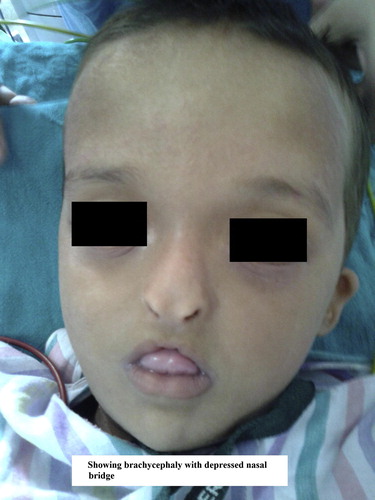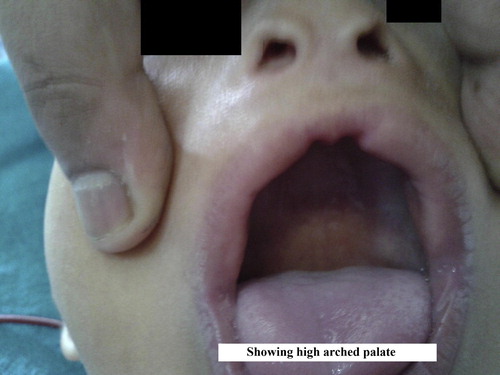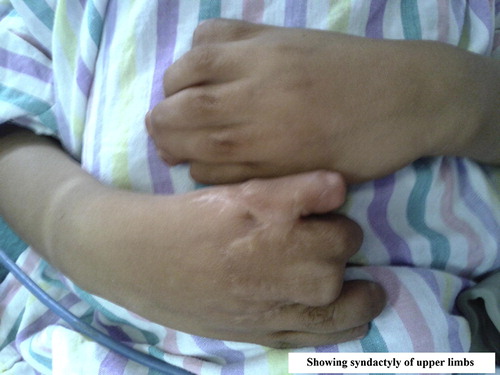Abstract
Apert syndrome is a congenital autosomal dominant disease characterized by brachycephaly, craniosynotosis, midface hypoplasia, hypertelorism, choanal stenosis, multidigit hand and foot syndactyly. Anaesthetic management of a child with Apert syndrome poses a great challenge to anaesthesiologist. The child should be evaluated thoroughly by history, examination and investigations for associated anamolies and managed accordingly. There is no definite recommendation for general or regional anaesthesia and also there are no known contraindications to specific anaesthetic agent and drug. However, whenever possible, regional anaesthesia should be preferred as the incidence of obstructive sleep apnoea is high in these patients. If general anaesthesia is planned, difficult airway cart should be kept ready. Temperature monitoring should be done intraoperatively and the patient should be monitored postoperatively for signs of airway obstruction.
KEYWORDS:
1 Introduction
Apert syndrome, named after the French paediatrician Eugene Apert, is a congenital autosomal dominant disease with an incidence of 1 per 160,000 live births that affects both males and females equally. The syndrome is characterized by bracycephaly, craniosynotosis, midface hypoplasia, hypertelorism, choanal stenosis, multidigit hand and foot syndactyly. Associated anamolies are rare and may include cardiac defects, polycystic kidneys and pyloric stenosis [Citation1]. We hereby present a case report of a 5 year child with Apert syndrome posted for syndactyly release of right upper and lower limb.
2 Case report
A 5 year male child weighing 15 kg was posted for syndactyly release of right upper and lower limb. He was a full term vaginally born child and was diagnosed as a case of Apert syndrome at the time of birth. Developmental milestones and mental intelligence were normal. On examination, bracycephaly, depressed nasal bridge, high arched palate and syndactyly of all the four limbs were present (). On systemic examination, chest was clear bilaterally and heart sounds were normal. Airway evaluation revealed Mallampati grade II. Relevant investigations including echocardiography were normal. General anaesthesia was planned for the procedure. Difficult airway cart was kept ready. In the operating room standard monitors were attached. Intravenous line was secured with 22 G cannula using Ringer lactate on left upper limb. Anaesthesia was induced with glycopyrrolate 0.1 mg, fentanyl 30 μg and thiopentone sodium 75 mg and after ensuring smooth mask ventilation, atracurium 7.5 mg was given and Proseal laryngeal mask airway of size 2 was inserted. Intraoperative anaesthesia was maintained with isoflurane in 67% N2O. Blood pressure, pulse, SpO2, ECG, EtCO2 and temperature monitoring were done throughout the procedure. Surgery lasted for 2 h and intraoperative course was uneventful. At the end of surgery, neuromuscular blockade was reversed with neostigmine and glycopyrrolate and Proseal laryngeal mask airway was removed. Postoperative course was uneventful.
3 Discussion
Anaesthetic management of a child with Apert syndrome poses a great challenge to anaesthesiologist. The child should be evaluated thoroughly by history, examination and investigations for associated anamolies and managed accordingly. Obtaining intravenous access may be more difficult in these patients particularly when they present for repeat surgical procedures.
There is no definite recommendation for general or regional anaesthesia and also there are no known contraindications to specific anaesthetic agent and drug. However, whenever possible, regional anaesthesia should be preferred as the incidence of obstructive sleep apnoea is high in these patients. In addition, regional anaesthesia reduces perioperative opioid requirements and thus reduces the opioid side effects like deep sedation, respiratory depression and nausea and vomiting. Regional anaesthesia could be difficult in these patients due to anatomical variations in shoulder joint and related structures and ultrasound guidance may help in these patients [Citation2].
These children have profuse secretions which can result in wheeze and increased airway irritability. Atropine has been suggested as a premedication to reduce secretions. Airway management may be difficult in these patients. Difficulty in bag mask ventilation should be anticipated due to midface hypoplasia and may require oral airway. Children with craniofacial anamolies often have abnormal airway. Apert syndrome may be associated with loss of lower and upper airway patency as well as respiratory complications during general anaesthesia [Citation3,Citation4].
Cartilagenous abnormalities of the trachea, fusion of the cervical vertebra, tracheal stenosis and angular deviation of the trachea may contribute to difficult intubation in these patients [Citation5]. Difficult airway cart should be kept ready. Tracheotomy is difficult in children and may lead to complications. These patients are prone to obstructed airway on induction and emergence due to obstructive sleep apnoea. Hence preoperative evaluation and optimization is mandatory [Citation6]. Abnormal skull development may lead to shallow orbits causing protrusion of the eyes and inability of the lids to close, known as exorbitism. Due to inadequate lid closure eyes are particularly susceptible to damage and hence eyes should be lubricated, taped and padded. Consideration should be given to avoid pressure points.
These patients tend to sweat a lot and unlike other patients undergoing syndactyly surgery do not appear to need warming when undergoing peripheral surgery to their limbs. If they are actively warmed, there is a risk of pyrexia, so temperature should always be monitored. Patient should be monitored postoperatively for signs of airway obstruction. Use of nasopharyngeal airway may be required in postoperative period to alleviate supraglottic obstruction although it may be difficult to place due to reduced nasoparyngeal volume.
To conclude Anaesthetic management of a patient with Apert syndrome may be challenging. The anaesthesiologist must be ready for airway problems, intubation difficulties and even visceral abnormalities. If difficult airway management is a concern, the induction of anaesthesia should be considered with inhalational agents and without neuromuscular blockers to maintain spontaneous ventilation. For these reasons thorough preoperative evaluation, optimization and a proper anaesthesia planning is essential.
Conflict of interest
None.
Notes
Available online 18 October 2014
References
- Y.MetodievN.GavrilovaA.KatzarovAnesthetic management of a child with Apert syndromeSaudi J Anaesth520118789
- V.W.S.ChanA.PerlasC.J.L.McCartneyR.BrullD.XuB.AbbasUltrasound guidance improves success rate of axillary brachial plexus blockCan J Anaesth542007176182
- T.ElwoodP.V.SarathyJ.M.GeiduschekG.A.UlmaH.W.KarlRespiratory complications during anaesthesia in Apert syndromePediatr Anaesth112001701703
- C.AtalayN.DoganS.YuksekA.F.ErdemAnesthesia and airway management in two cases of Apert syndrome: case reportsEAJM4020089193
- G.P.MorrisM.G.CooperDifficult tracheal intubation following midface distraction surgeryPediatr Anaesth10200099102
- K.PatelD.ChavanP.SawantAnesthesia management in a patient of Apert syndromeAnesth Essays Res72013133135




